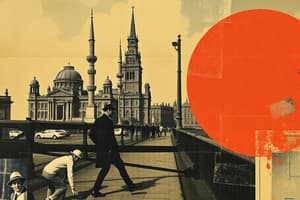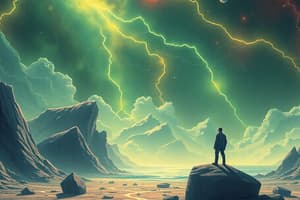Podcast
Questions and Answers
What characterizes monopolistic competition?
What characterizes monopolistic competition?
- Price control by a single seller
- Few sellers and high barriers to entry
- No product differentiation among sellers
- Many sellers with differentiated products (correct)
Which of the following is associated with oligopoly?
Which of the following is associated with oligopoly?
- A homogeneous product
- Perfect competition among firms
- No barriers to entry
- Significant interdependence among sellers (correct)
What does GDP measure?
What does GDP measure?
- The average income of households in a nation
- The level of inflation in an economy
- The total income of a country's citizens
- The total market value of final goods and services produced (correct)
What is inflation?
What is inflation?
Which fiscal policy action can influence the economy?
Which fiscal policy action can influence the economy?
What does the unemployment rate measure?
What does the unemployment rate measure?
What is the primary focus of development economics?
What is the primary focus of development economics?
Which of the following is a significant indicator in international economics?
Which of the following is a significant indicator in international economics?
What does the term 'scarcity' refer to in economics?
What does the term 'scarcity' refer to in economics?
Which of the following best describes 'opportunity cost'?
Which of the following best describes 'opportunity cost'?
How is 'demand' defined in economics?
How is 'demand' defined in economics?
What does the Law of Demand state?
What does the Law of Demand state?
Which of the following factors is NOT likely to affect supply?
Which of the following factors is NOT likely to affect supply?
In a perfectly competitive market, which of the following is true?
In a perfectly competitive market, which of the following is true?
What does a Production Possibility Curve (PPC) illustrate?
What does a Production Possibility Curve (PPC) illustrate?
Which of the following describes a monopoly?
Which of the following describes a monopoly?
Flashcards
Scarcity
Scarcity
Limited resources cannot fulfil unlimited wants and needs, forcing choices.
Opportunity Cost
Opportunity Cost
The value of the next best alternative given up when a choice is made.
Demand
Demand
Relationship between a good's price and the quantity consumers want to buy at various prices.
Law of Demand
Law of Demand
Signup and view all the flashcards
Supply
Supply
Signup and view all the flashcards
Law of Supply
Law of Supply
Signup and view all the flashcards
Market Equilibrium
Market Equilibrium
Signup and view all the flashcards
Perfect Competition
Perfect Competition
Signup and view all the flashcards
Monopolistic Competition
Monopolistic Competition
Signup and view all the flashcards
Oligopoly
Oligopoly
Signup and view all the flashcards
GDP
GDP
Signup and view all the flashcards
Inflation
Inflation
Signup and view all the flashcards
Unemployment
Unemployment
Signup and view all the flashcards
Economic Growth
Economic Growth
Signup and view all the flashcards
Recessions
Recessions
Signup and view all the flashcards
GDP Growth Rate
GDP Growth Rate
Signup and view all the flashcards
Study Notes
Introduction to Economics
- Economics is the social science that studies how societies allocate scarce resources to satisfy unlimited wants and needs.
- It examines the production, distribution, and consumption of goods and services.
- Two main branches are microeconomics (individual markets) and macroeconomics (overall economy).
- Key concepts include supply and demand, opportunity cost, scarcity, efficiency, and equity.
Basic Economic Concepts
- Scarcity: Limited resources cannot fulfill unlimited wants/needs. This forces choices.
- Opportunity Cost: The value of the next best alternative foregone when a choice is made.
- Needs vs. Wants: Needs are necessities for survival, wants are desires.
- Factors of Production: Resources used to produce goods and services (land, labor, capital, entrepreneurship).
- Production Possibility Curve (PPC): Shows the maximum combination of outputs an economy can produce.
- Economic Systems: Different ways societies organize their economies (traditional, command, market, mixed).
Demand and Supply
- Demand: The relationship between the price of a good or service and the quantity consumers are willing and able to buy at various prices. It is usually inversely proportional to price.
- Law of Demand: As price increases, quantity demanded decreases, and vice versa.
- Demand Schedule/Curve: Illustrates the demand relationship.
- Factors affecting Demand: Consumer income, tastes and preferences, price of related goods (substitutes and complements), expectations, number of buyers.
- Supply: The relationship between the price of a good or service and the quantity producers are willing and able to sell at various prices. It is usually directly proportional to price.
- Law of Supply: As price increases, quantity supplied increases, and vice versa.
- Supply Schedule/Curve: Illustrates the supply relationship.
- Factors affecting Supply: Input prices, technology, government regulations, number of sellers, producer expectations.
- Market Equilibrium: The point where the demand and supply curves intersect, determining market price and quantity.
Market Structures
- Perfect Competition: Large number of buyers and sellers, identical products, free entry and exit, no price control by individual firms.
- Monopoly: Single seller, unique product, significant barriers to entry, price control.
- Monopolistic Competition: Many sellers, differentiated products, relatively easy entry and exit, some price control.
- Oligopoly: Few sellers, significant interdependence, potential for price wars, barriers to entry.
Macroeconomics
- Gross Domestic Product (GDP): Total market value of all final goods and services produced within a country's borders in a specific time period.
- Inflation: General increase in the price level of goods and services in an economy over a period of time.
- Unemployment: The situation where a person who is actively seeking employment is unable to find work.
- Monetary Policy: Actions taken by a central bank to manipulate the money supply and credit conditions to stimulate or restrain economic activity.
- Fiscal Policy: Government policies related to taxation and government spending to influence the economy.
- Economic Growth: Increase in the production of goods and services over a period of time.
- Recessions: Periods of significant decline in economic activity.
Economic Indicators
- GDP Growth Rate: Measures the rate at which a country's GDP is expanding.
- Inflation Rate: Measures the rate at which prices are rising.
- Unemployment Rate: Measures the percentage of the labor force that is unemployed.
- Consumer Price Index (CPI): Measures the average change over time in the prices paid by urban consumers for a basket of consumer goods and services.
- Interest Rates: Influence borrowing and investment decisions influencing economic activity.
Development Economics
- Focuses on economic growth and development in less developed countries.
- Deals with issues like poverty, inequality, and infrastructure.
- Addresses factors like human capital, institutions, and technology.
International Economics
- Studies international trade, finance, and monetary systems.
- Discusses exchange rates, balance of payments, trade agreements.
- Importance of globalisation.
Conclusion
- Economics provides a framework to understand how societies make decisions with limited resources.
- Understanding economic concepts is crucial for informed decision-making and assessing various situations.
Studying That Suits You
Use AI to generate personalized quizzes and flashcards to suit your learning preferences.




